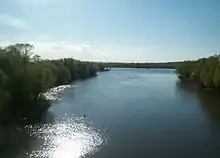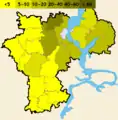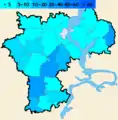Ulyanovsk Oblast
Ulyanovsk Oblast (Russian: Улья́новская о́бласть, Ulyanovskaya oblast) is a federal subject of Russia (an oblast). It is located in the Volga Federal District. Its administrative center is the city of Ulyanovsk. Population: 1,292,799 (2010 Census).[9]
Ulyanovsk Oblast | |
|---|---|
| Ульяновская область | |
 Flag .svg.png.webp) Coat of arms | |
| Anthem: Anthem of Ulyanovsk Oblast[1] | |
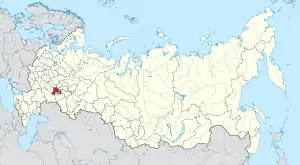 | |
| Coordinates: 53°57′N 47°55′E | |
| Country | Russia |
| Federal district | Volga[2] |
| Economic region | Volga[3] |
| Established | January 19, 1943[4] |
| Administrative center | Ulyanovsk |
| Government | |
| • Body | Legislative Assembly[5] |
| • Governor[6] | Sergey Morozov[7] |
| Area | |
| • Total | 37,300 km2 (14,400 sq mi) |
| Area rank | 62nd |
| Population (2010 Census)[9] | |
| • Total | 1,292,799 |
| • Estimate (2018)[10] | 1,246,618 (−3.6%) |
| • Rank | 37th |
| • Density | 35/km2 (90/sq mi) |
| • Urban | 73.5% |
| • Rural | 26.5% |
| Time zone | UTC+4 (UTC+04:00 |
| ISO 3166 code | RU-ULY |
| License plates | 73, 173 |
| OKTMO ID | 73000000 |
| Official languages | Russian[12] |
| Website | http://ulgov.com |
Geography
Ulyanovsk Oblast borders with Chuvashia (N), Tatarstan (NE), Samara Oblast (E), Saratov Oblast (S), Penza Oblast (W), and Mordovia (NW).
It is located on the northern edge of Central Steppes. A quarter of its territory is covered with deciduous forests; the rest is covered with steppes and meadows. The oblast is divided in half by the Volga River. Hilly areas to the west of the Volga are known as Volga Upland (elevations up to 358 m (1,175 ft) ). Eastern part of the oblast is mostly flat. The water table occupies about 6% of territory.
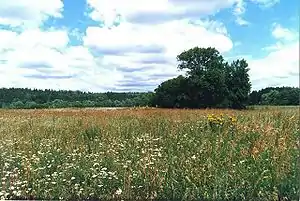
Ulyanovsk Oblast has moderately continental, highly volatile climate. Temperature averages at +19 °C (66°F) in July, and −11 °C (12°F) in January. As weather systems move in and out of the area, average daily temperatures often change more than +25 °C (77°F) in the matter of days. Fixed snow cover is typically present from November to the beginning of April. Overnight frosts occur until late May, restricting agriculture to cold-resistant plants such as rye and winter wheat. Annual precipitation drops out 400 mm (16 inches) a year.
Nature
Ulyanovsk Oblast is located in the zones of wooded plain and broad-leaved scaffolding.
Soils are predominantly chernozem.
Forests occupy 1/4 territories. In the northwest — large massifs of oak forest with the participation of linden, maple; in the Transvolga region — meadow steppes, separate pine borons.
The area is inhabited by moose, marten, squirrel, hare (white and other) as well as numerous planktonic and marshy- coastal birds. Kuybyshev Reservoir is home to fish such as bream, pike-perch, carp and others. Ulyanovsk Oblast also has a concentrated wasp population.
The protected areas are found on the territory of region: national park Sengiley Mountains, the guarding zone of state preserve “Volga wooded plain”, the monuments of nature Undory mineral source, relict forests etc.
History
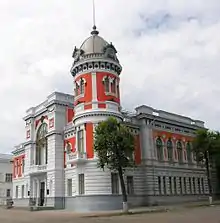
The first settlements of Middle Volga people were established in this area of Volga more than 100,000 years ago, according to archaeological science. The presence of human groups in the Ulyanovsk Volga region in the Paleolithic show separate parking and location of stone tools and bones found in the estuary. Cheremshan Tunguz on the peninsula, on the shores of the Volga in the region of Undory resort.
In the 8th and 9th centuries Ulyanovsk Volga region became a part of the early Volga Bulgaria, as a union of nomadic Turkic and sedentary Finno-Ugric tribes.
In the late 14th and early 15th century, the devastating Central Asian ruler Tamerlane began desolation territory of the Volga Ulyanovsk. Since the late 1430s the region was a part of the Kazan Khanate. After the pacification of the territory of the future of his governorship Simbirsk gradually settled by Ruthenians, who mingled with the local Tatars.
In the late 1640s, under the leadership of Bogdan Hitrovo, construction of the Karsunsky-Simbirsk defense line began (1647-1654 biennium).
Twenty-two years after its founding, the city of Simbirsk had to withstand a siege of the Cossacks, led by Ataman Stepan Razin.
In the 18th century in connection with the expansion of the territory of the Russian state, in particular, to the east, and began to develop intensively populated southern regions of the present territory of the Ulyanovsk region. Simbirsk began to lose its status of strategic military importance, but remained the provincial center.
Russian revolution
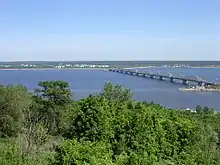
The Bolsheviks took power in Simbirsk one and a half month after the October Revolution—December 10, 1917. In 1918, the province was at the heart of the civil war. In July 1918 Simbirsk was captured by troops led by White Russian tsarist General Komuch Kappel. But on September 12 the Bolsheviks recaptured the city, resulting in the restoration of communism. The Red Army victory was led by the "Iron Division". Simbirsk was the headquarters of the Revolutionary Military Council of the eastern front. The ammunition factory in Simbirsk was essential to ensuring the Red Army victory.
In 1924 Simbirsk was renamed Ulyanovsk. On May 14, 1928 the Ulyanovsk Governorate of the RSFSR was abolished.[13] The Province, together with Penza, Samara and Orenburg became part of the newly formed Middle Volga region.
World War II

Since the beginning of the Great Patriotic War in Ulyanovsk, being the rear, the evacuated enterprises, institutions and people from the western regions of the country, from Moscow and Leningrad. January 19, 1943 from several districts of Kuybyshev and Penza Oblasts formed Ulyanovsk Oblast.
Post War development
In the 1950 and 1960s in the creation of new enterprises (factory of heavy and unique machines, mechanical plant, Dimitrovgrad Research Institute of Atomic Reactors, etc.), road bridge over the Volga River and the airport in Ulyanovsk. In 1970, the then General Secretary of the Communist Party of the Soviet Union Leonid Brezhnev, inaugurated memorial museum of Lenin. On 30 October 1997, Ulyanovsk, alongside Astrakhan, Kirov, Murmansk, and Yaroslavl signed a power-sharing agreement with the government of Russia, granting it autonomy.[14] The agreement would be abolished on 31 December 2001.[15]
Politics

During the Soviet period, the high authority in the oblast was shared between three persons: The first secretary of the Ulyanovsk CPSU Committee (who in reality had the biggest authority), the chairman of the oblast Soviet (legislative power), and the Chairman of the oblast Executive Committee (executive power). Since 1991, CPSU lost all the power, and the head of the Oblast administration, and eventually the governor was appointed/elected alongside elected regional parliament.
The Charter of Ulyanovsk Oblast is the fundamental law of the region. The Legislative Assembly of Ulyanovsk Oblast is the province's standing legislative (representative) body. The Legislative Assembly exercises its authority by passing laws, resolutions, and other legal acts and by supervising the implementation and observance of the laws and other legal acts passed by it. The highest executive body is the Oblast Administration, which includes territorial executive bodies such as district administrations, committees, and commissions that facilitate development and run the day to day matters of the province. The Oblast administration supports the activities of the Governor who is the highest official and acts as guarantor of the observance of the oblast Charter in accordance with the Constitution of Russia.
Administrative divisions
Demographics
Population: 1,292,799 (2010 Census);[9] 1,382,811 (2002 Census);[16] 1,400,806 (1989 Census).[17]
55% of residents of Ulyanovsk Oblast live in two cities with population above 25,000—Ulyanovsk and Dimitrovgrad.
The ethnic composition is as follows:[9]
- 73.6% Russian
- 12.2% Tatar
- 7.7% Chuvash
- 3.2% Mordva
- 3.3% others
- 67,890 people were registered from administrative databases, and could not declare an ethnicity. It is estimated that the proportion of ethnicities in this group is the same as that of the declared group.[18]

For the first half of 2007, the birth rate was 9.0 per 1000 The area population is reduced and for 20 years since 1991 has decreased on 200 thousand persons.
- Total fertility rate:[19]
2009 - 1.40 | 2010 - 1.41 | 2011 - 1.45 | 2012 - 1.57 | 2013 - 1.61 | 2014 - 1.67 | 2015 - 1.71 | 2016 - 1.71(e)
Religion
Economy
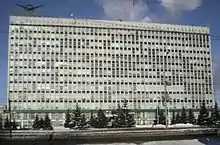
Ulyanovsk Oblast is part of the Volga economic region.
Ulyanovsk Oblast has an abundance of land, water, forest, and mineral resources. Ulyanovsk Region also has substantial reserves of other raw materials used in industry, such as various kinds of sand, cement materials, clays, and peat. One of the largest quartz sand deposits in the CIS, the Tashlinskoe deposit, is located in the region.
Ulyanovsk and Dimitrovgrad are industrial cities and contain a number of large plants and factories. Rural part of Ulyanovsk Oblast is agricultural and is focused primarily on animal husbandry, to the lesser extent on crop farming. There are two resorts in Ulyanovsk Oblast territory - "Bely Yar" and "Dubki".
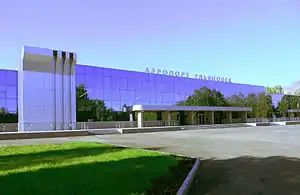
City of Ulyanovsk is a major, diversified, industrial hub for aircraft and auto industries.
The UAZ automobile manufacturing plant, now a subsidiary of Sollers JSC; Aviastar-SP Aircraft Company, now a part of United Aircraft Corporation; Scientific and Production Association "Mars" (manufactures industrial control systems for the Russian Navy), now part of state-owned conglomerate Agat; Ulyanovsk Cartridge Works (manufactures ammunition for firearms); Ulyanovsk Motor Plant (russian.Ульяновский моторный завод, UMZ) and Ulyanovsk Mechanical Plant (russian.Ульяновский механический завод, UMZ, subsidiary of JSC Almaz-Antey) are based in the city along with a variety of light industry and food-processing enterprises. Other developed sectors include the flour-milling, meat, butter-making, starch and molasses, distilling, building material, and woodworking industries.
In addition, a global, international airline for unique and heavy cargo , Volga-Dnepr Airlines is based in the city too.
There are many manufacturing facilities of foreign corporations such as Legrand (company), Mars, Incorporated,[22] Takata-Petri,[23] Anadolu Efes S.K..,[24] ALFA (Mexico) and others.
Banking is mostly represented by national banks such as Sberbank, VTB Bank, Alfa-Bank, Bin Bank, Ak Bars Bank, MDM Bank, Trust Bank and also regional banks from Ulyanovsk Oblast.
Ulyanovsk has also a strong military base presence in town. The 31st Airborne Brigade of the Russian Airborne Troops of the armed forces is based in Ulyanovsk.
Tourism and Hospitality Industry
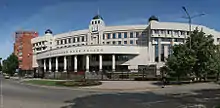
Tourism is a growing industry in this region because of Volga micro-climate and historical significance of Simbirsk.[25] Hilton Hotel Group and Marriott Hotels & Resorts are building their hotels in the downtown area.
The region of Undory, a driving distance from Ulyanovsk is famous for its spas and mineral water. The city offers many options for sports enthusiasts. The countryside is ideal for outdoor and water sports. The springs of Undory have been known for more than 200 years. The water at spa is rich in sodium chloride, and comes from artesian wells.
Retail and Restaurants
Retail is a growing business segment in Ulyanovsk Region. International retailers such as Auchan SA, METRO AG, Media Markt, Decathlon as well as local Russian chains such as X5 Retail, Magnit, Lenta (retail), Sportmaster, M.video opened up their stores in Ulyanovsk.
Aqua Mall is an American-type mall concept that opened in Ulyanovsk on the banks of Sviyaga river with modern cinema theater, IMAX. The city has also a large presence of international fast food brands such as McDonald's, Burger King, Baskin Robbins, Sbarro, KFC and others. Local Russian brands are also well-represented in this market.
Regional automobile code is 73. Ulyanovsk has 2 airports.
Education
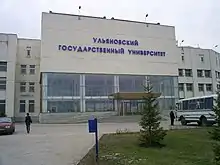
- Ulyanovsk State University, established in 1988 as a branch of Moscow State University. At the present time, UlSU is one of the largest higher educational institutions in the Volga region, comprising 6 institutes, 6 independent faculties, 2 affiliates, 5 junior colleges, 6 learning centers. UlSU enrolls about 15 thousand students annually, among them 125 foreign citizens from 20 countries of the world.
- Ulyanovsk State Technical University, established in 1957 as Ulyanovsk Polytech University. Today Ulyanovsk State Technical University features over 14000 students on different education programs at 10 faculties and 48 departments.
- Ulyanovsk State Pedagogical University, established in 1932.
- Ulyanovsk State Agricultural Academy, established in 1943.
- Ulyanovsk Higher Civil Aviation School, founded in 1935 as a training center, designed for training and retraining of flight crews of civil aircraft. In 1992, raised its status to the present. Has branches in Krasny Kut, Saratov Oblast and Sasovo, Ryazan Oblast. When it has Main industry museum of civil aviation history (Ulyanovsk aircraft museum), established in 1983.
There is also a number of technical and medical colleges in Ulyanovsk.
Sports
Bandy is traditionally the most popular sport in Ulyanovsk Oblast.[26]Volga[27] plays in the Russian Bandy Super League. The other club Simbirsk plays in the 2nd division. An indoor arena for bandy, Volga-Sport-Arena, has been built, as one of the first in Russia. It has a capacity of 5 000. The outdoor stadium will be modernised and have a capacity of 18 000. The 2016 Bandy World Championship is being played in Ulyanovsk.[28] and Dimitrovgrad.
In association football, FC Volga plays in "Urals-Volga" zone of the Russian Second Division.
Ulyanovsk also hosted matches of first qualifying round UEFA Women's Under-17 Championship 2014. Matches were held at "Trud" Football Stadium in the downtown Ulyanovsk.
Overall sports get a lot of support from the Ulyanovsk Oblast government.
Sister relationships
References
Notes
- Law #197-ZO
- Президент Российской Федерации. Указ №849 от 13 мая 2000 г. «О полномочном представителе Президента Российской Федерации в федеральном округе». Вступил в силу 13 мая 2000 г. Опубликован: "Собрание законодательства РФ", No. 20, ст. 2112, 15 мая 2000 г. (President of the Russian Federation. Decree #849 of May 13, 2000 On the Plenipotentiary Representative of the President of the Russian Federation in a Federal District. Effective as of May 13, 2000.).
- Госстандарт Российской Федерации. №ОК 024-95 27 декабря 1995 г. «Общероссийский классификатор экономических регионов. 2. Экономические районы», в ред. Изменения №5/2001 ОКЭР. (Gosstandart of the Russian Federation. #OK 024-95 December 27, 1995 Russian Classification of Economic Regions. 2. Economic Regions, as amended by the Amendment #5/2001 OKER. ).
- Charter of Ulyanovsk Oblast, Article 1
- Charter of Ulyanovsk Oblast, Article 9
- Charter of Ulyanovsk Oblast, Article 19
- Official website of Ulyanovsk Oblast. Sergey Morozov, Governor of Ulyanovsk Oblast (in Russian)
- Федеральная служба государственной статистики (Federal State Statistics Service) (May 21, 2004). "Территория, число районов, населённых пунктов и сельских администраций по субъектам Российской Федерации (Territory, Number of Districts, Inhabited Localities, and Rural Administration by Federal Subjects of the Russian Federation)". Всероссийская перепись населения 2002 года (All-Russia Population Census of 2002) (in Russian). Federal State Statistics Service. Retrieved November 1, 2011.
- Russian Federal State Statistics Service (2011). "Всероссийская перепись населения 2010 года. Том 1" [2010 All-Russian Population Census, vol. 1]. Всероссийская перепись населения 2010 года [2010 All-Russia Population Census] (in Russian). Federal State Statistics Service.
- "26. Численность постоянного населения Российской Федерации по муниципальным образованиям на 1 января 2018 года". Federal State Statistics Service. Retrieved January 23, 2019.
- "Об исчислении времени". Официальный интернет-портал правовой информации (in Russian). June 3, 2011. Retrieved January 19, 2019.
- Official throughout the Russian Federation according to Article 68.1 of the Constitution of Russia.
- " 1 2 Сегодня Ульяновская область отмечает 69 лет, ulpressa.ru"
- "Yeltsin Signs Power-Sharing Agreements With Five More Russian Regions". Jamestown. November 3, 1997. Retrieved May 2, 2019.
- Chuman, Mizuki. "The Rise and Fall of Power-Sharing Treaties Between Center and Regions in Post-Soviet Russia" (PDF). Demokratizatsiya: 146.
- Russian Federal State Statistics Service (May 21, 2004). "Численность населения России, субъектов Российской Федерации в составе федеральных округов, районов, городских поселений, сельских населённых пунктов – районных центров и сельских населённых пунктов с населением 3 тысячи и более человек" [Population of Russia, Its Federal Districts, Federal Subjects, Districts, Urban Localities, Rural Localities—Administrative Centers, and Rural Localities with Population of Over 3,000] (XLS). Всероссийская перепись населения 2002 года [All-Russia Population Census of 2002] (in Russian).
- "Всесоюзная перепись населения 1989 г. Численность наличного населения союзных и автономных республик, автономных областей и округов, краёв, областей, районов, городских поселений и сёл-райцентров" [All Union Population Census of 1989: Present Population of Union and Autonomous Republics, Autonomous Oblasts and Okrugs, Krais, Oblasts, Districts, Urban Settlements, and Villages Serving as District Administrative Centers]. Всесоюзная перепись населения 1989 года [All-Union Population Census of 1989] (in Russian). Институт демографии Национального исследовательского университета: Высшая школа экономики [Institute of Demography at the National Research University: Higher School of Economics]. 1989 – via Demoscope Weekly.
- "ВПН-2010". www.perepis-2010.ru.
- "Каталог публикаций::Федеральная служба государственной статистики". www.gks.ru.
- "Arena: Atlas of Religions and Nationalities in Russia". Sreda, 2012.
- 2012 Arena Atlas Religion Maps. "Ogonek", № 34 (5243), 27/08/2012. Retrieved 21/04/2017. Archived.
- http://www.mars.com/global/about-mars/where-we-operate.aspx Where we operate
- http://www.takata.com/en/about/locations02.html#l03 Archived February 15, 2015, at the Wayback Machine
- "Anadolu Efes". www.anadoluefes.com.
- Planet, Lonely. "Ulyanovsk travel - Lonely Planet". Lonely Planet.
- "Google Translate". translate.google.com.
- "volgahc.ru". www.volgahc.ru.
- "Russia and Vietnam cooperation". vietnamnews.ru. Archived from the original on February 12, 2009.
Sources
- Законодательное Собрание Ульяновской области. Постановление №31/311 от 19 мая 2005 г. «Устав Ульяновской области», в ред. Закона №91-ЗО от 2 сентября 2015 г. «О поправках к Уставу Ульяновской области». Вступил в силу через десять дней после официального опубликования (4 июня 2005 г.). Опубликован: "Ульяновская правда", №51(22.365), 24 мая 2005 г. (Legislative Assembly of Ulyanovsk Oblast. Resolution #31/311 of May 19, 2005 Charter of Ulyanovsk Oblast, as amended by the Law #91-ZO of September 2, 2015 On Amending the Charter of Ulyanovsk Oblast. Effective as of the day which is ten days after the official publication.).
- Законодательное Собрание Ульяновской области. Закон №197-ЗО от 6 декабря 2006 г. «О гимне Ульяновской области», в ред. Закона №118-ЗО от 29 сентября 2015 г. «О внесении изменения в статью 4 Закона Ульяновской области "О гимне Ульяновской области"». Вступил в силу 20 декабря 2006 г. Опубликован: "Ульяновская правда", №97 (22.533), 9 декабря 2006 г. (Legislative Assembly of Ulyanovsk Oblast. Law #197-ZO of December 6, 2006 On the Anthem of Ulyanovsk Oblast, as amended by the Law #118-ZO of September 29, 2015 On Amending Article 4 of the Law of Ulyanovsk Oblast "On the Anthem of Ulyanovsk Oblast". Effective as of December 20, 2006.).
External links
| Wikimedia Commons has media related to Ulyanovsk Oblast. |
- . Encyclopædia Britannica (11th ed.). 1911.

